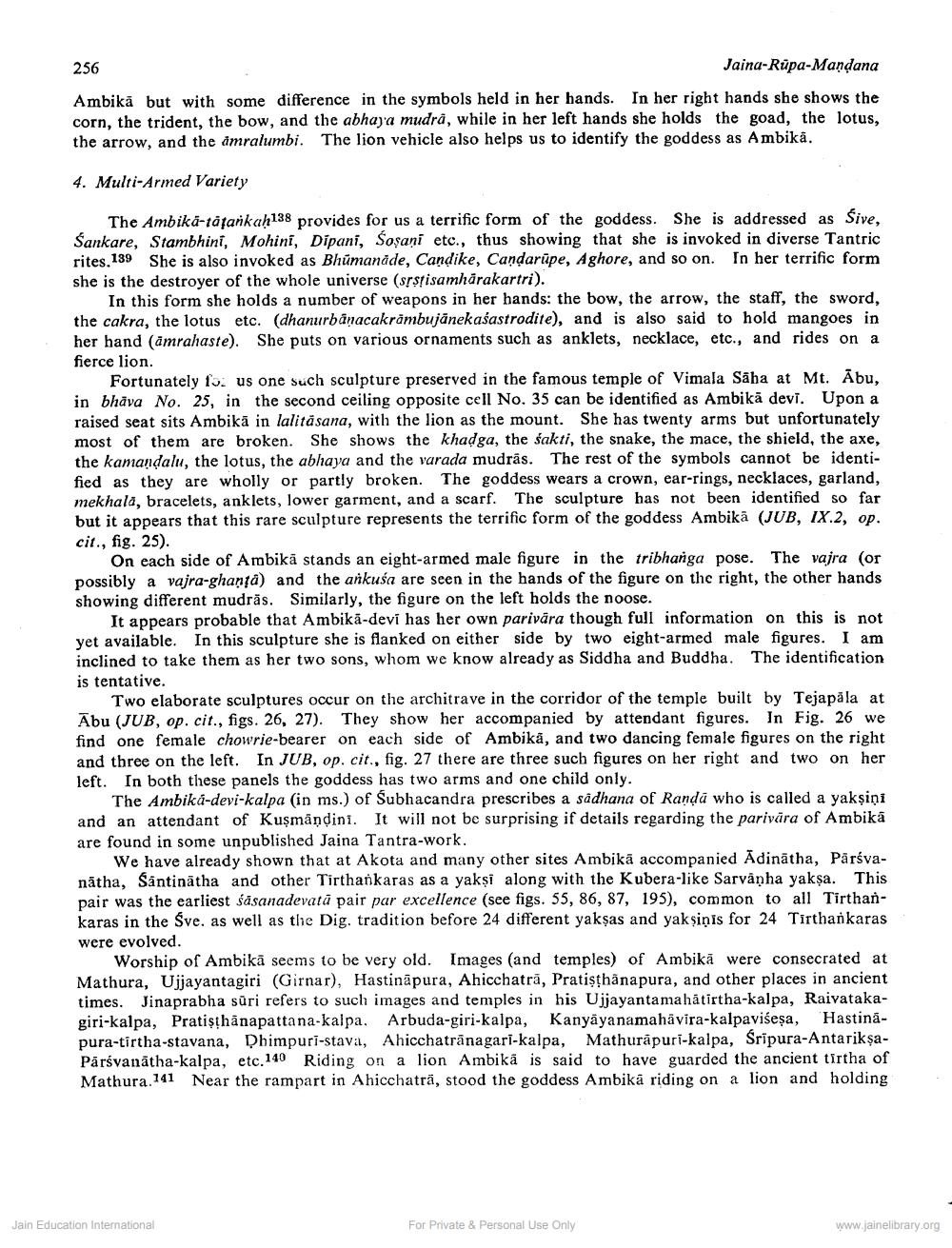________________
256
Jaina-Rupa-Mandana Ambikā but with some difference in the symbols held in her hands. In her right hands she shows the corn, the trident, the bow, and the abhaya mudrå, while in her left hands she holds the goad, the lotus, the arrow, and the amralumbi. The lion vehicle also helps us to identify the goddess as Ambika.
4. Multi-Armed Variety
The Ambikä-tatarkah138 provides for us a terrific form of the goddess. She is addressed as Sive, Sankare, Stambhini, Mohini, Dipani, Soşani etc., thus showing that she is invoked in diverse Tantric rites. 139 She is also invoked as Bhūmanåde, Candike, Candarūpe, Aghore, and so on. In her terrific form she is the destroyer of the whole universe (srstisamhärakartri).
In this form she holds a number of weapons in her hands: the bow, the arrow, the staff, the sword, the cakra, the lotus etc. (dhanurbanacakrämbujānekaśastrodite), and is also said to hold mangoes in her hand (amrahaste). She puts on various ornaments such as anklets, necklace, etc., and rides on a fierce lion.
Fortunately fo. us one such sculpture preserved in the famous temple of Vimala Saha at Mt. Ābu, in bhāva No. 25, in the second ceiling opposite cell No. 35 can be identified as Ambikā devi. Upon a raised seat sits Ambikā in lalitäsana, with the lion as the mount. She has twenty arms but unfortunately most of them are broken. She shows the khadga, the sakti, the snake, the mace, the shield, the axe, the kamandalu, the lotus, the abhaya and the varada mudrās. The rest of the symbols cannot be identified as they are wholly or partly broken. The goddess wears a crown, ear-rings, necklaces, garland, mekhald, bracelets, anklets, lower garment, and a scarf. The sculpture has not been identified so far but it appears that this rare sculpture represents the terrific form of the goddess Ambika (JUB, IX.2, op. cit., fig. 25).
On each side of Ambikā stands an eight-armed male figure in the tribhanga pose. The vajra (or possibly a vajra-ghantà) and the ankusa are seen in the hands of the figure on the right, the other hands showing different mudrās. Similarly, the figure on the left holds the noose.
It appears probable that Ambika-devi has her own parivāra though full information on this is not yet available. In this sculpture she is flanked on either side by two eight-armed male figures. I am inclined to take them as her two sons, whom we know already as Siddha and Buddha. The identification is tentative.
Two elaborate sculptures occur on the architrave in the corridor of the temple built by Tejapala at Ābu (JUB, op. cit., figs. 26, 27). They show her accompanied by attendant figures. In Fig. 26 we find one female chowrie-bearer on each side of Ambika, and two dancing female figures on the right and three on the left. In JUB, op. cit., fig. 27 there are three such figures on her right and two on her left. In both these panels the goddess has two arms and one child only.
The Ambika-devi-kalpa (in ms.) of Subhacandra prescribes a sådhana of Rand, who is called a yakşini and an attendant of Kuşmändini. It will not be surprising if details regarding the parivāra of Ambika are found in some unpublished Jaina Tantra-work.
We have already shown that at Akota and many other sites Ambikä accompanied Adinatha, Pärsvanātha, Säntinātha and other Tirthankaras as a yakşi along with the Kubera-like Sarvāṇha yakşa. This pair was the earliest śasanadevatà pair par excellence (see figs. 55, 86, 87, 195), common to all Tirthankaras in the Sve, as well as the Dig. tradition before 24 different yakşas and yaksiņis for 24 Tirthankaras were evolved.
Worship of Ambikā seems to be very old. Images (and temples) of Ambika were consecrated at Mathura, Ujjayantagiri (Girnar), Hastināpura, Ahicchatrā, Pratişthanapura, and other places in ancient times. Jinaprabha sūri refers to such images and temples in his Ujjayantamahātirtha-kalpa, Raivatakagiri-kalpa, Pratişthānapattana-Kalpa. Arbuda-giri-kalpa, Kanyāyanamahāvira-kalpavišesa, Hastinapura-tirtha-stavana, Dhimpuri-stava, Ahicchatrā nagari-kalpa, Mathurāpuri-kalpa, Sripura-AntariksaPārsvanatha-kalpa, etc.140 Riding on a lion Ambika is said to have guarded the ancient tirtha of Mathura.141 Near the rampart in Ahicchaträ, stood the goddess Ambikā riding on a lion and holding
Jain Education International
Jain Education International
For Private & Personal Use Only
www.jainelibrary.org




